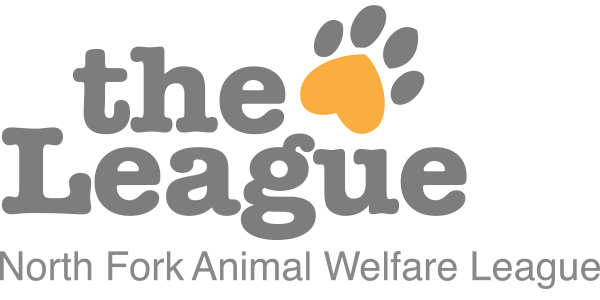Spay/Neuter Awareness Month
Promoting Responsible Pet Ownership
Animal welfare organizations worldwide join hands to commemorate Spay/Neuter Awareness Month this February—a crucial period dedicated to advocating for the responsible management of pet populations.
At the North Fork Animal Welfare League (NFAWL), we advocate for responsible pet ownership and stand firmly in our commitment to championing the spaying and neutering of animals. Let us delve into the significance of this month to our beloved pets and the imperative need for widespread awareness about this essential aspect of pet care.
The Urgent Need for Awareness
Despite the significant strides made in animal welfare over the years, pet overpopulation remains a pressing issue. The heartbreaking reality is that millions of cats and dogs end up in shelters annually, with a considerable number facing euthanasia due to the lack of suitable homes. This crisis underscores the critical importance of spaying and neutering as a proactive measure to curb the proliferation of homeless animals.
The Timing of Spay/Neuter
While spaying and neutering can be performed at any age, veterinarians often recommend scheduling these procedures around the age of six months before sexual maturity sets in. Early-age spaying and neutering, also known as pediatric spaying and neutering, have gained popularity due to their numerous benefits, including quicker recovery times and reduced risk of certain health issues.
The Benefits of Spaying and Neutering
Beyond population control, spaying and neutering offer a myriad of benefits for both pets and their human companions:
1. Health Benefits
Spaying and neutering significantly reduce the risk of various reproductive cancers and eliminate the potential for life-threatening conditions such as pyometra (uterine infection) in females.
2. Behavioral Improvement
Neutered males exhibit decreased aggression and are less likely to engage in undesirable behaviors such as roaming, marking territory, and fighting. Similarly, spaying females eliminates heat cycles, which often leads to restlessness and vocalization.
3. Curbing Unwanted Behaviors
By reducing hormonal urges, spaying and neutering can mitigate undesirable behaviors such as spraying, yowling, and aggression toward other animals.
4. Longer Lifespan
Research indicates that spayed and neutered pets tend to live longer, healthier lives compared to their intact counterparts. This is attributed to the reduced risk of reproductive cancers and other associated health complications.
5. Enhanced Quality of Life
Spaying and neutering can contribute to a better quality of life for pets by alleviating the stress and discomfort associated with mating behaviors, such as incessant vocalization and attempts to escape.
Addressing Concerns and Considerations
While spaying and neutering offer numerous benefits, it's essential to address common concerns and considerations associated with these procedures:
● Cost: Some pet owners may be deterred by the perceived cost of spaying and neutering. However, many animal welfare organizations and veterinary clinics offer low-cost or subsidized options to make these procedures accessible to all.
● Anesthesia Risks: While anesthesia is generally safe, there is always a slight risk associated with its administration. Veterinarians take precautions to minimize these risks by conducting pre-operative evaluations and monitoring the patient closely throughout the procedure.
● Recovery Period: Pets undergoing spaying or neutering require a period of rest and recovery to heal properly. Pet owners should follow post-operative care instructions provided by their veterinarian and monitor their pets for any signs of complications.
Dispelling Common Myths
Despite the overwhelming evidence supporting the benefits of spaying and neutering, misconceptions still abound. It is essential to address and dispel these myths to encourage informed decision-making:
Myth: Spaying or neutering will alter my pet's personality.
Fact: While spaying and neutering may lead to behavioral changes, such as decreased aggression and roaming, they do not fundamentally alter your pet's personality. Instead, they can promote a more balanced and contented demeanor.
Myth: My pet will become overweight after being spayed or neutered.
Fact: The primary cause of obesity in pets is overfeeding and lack of exercise, not sterilization. By monitoring your pet's diet and providing regular exercise, you can maintain their optimal weight post-surgery.
Our Commitment at NFAWL
As advocates for animal welfare, it is incumbent upon us to promote the importance of spaying and neutering year-round, not just during Spay/Neuter Awareness Month. By educating about the benefits of these procedures and supporting initiatives that make them accessible to all, we can make a tangible difference in the lives of countless animals.
At NFAWL, we remain steadfast in our dedication to spaying and neutering as integral components of responsible pet ownership. Through our collective efforts, we can create a future where every pet can live a healthy, happy, and fulfilling life.
Spay/Neuter Awareness Month serves as a poignant reminder of our shared responsibility to protect and care for the animals that enrich our lives. By embracing spaying and neutering as not only a means of population control but also as a fundamental aspect of compassionate pet care, we can create a world where every animal is valued and cherished.
Let us seize the opportunity to amplify our voices and advocate for the welfare of animals. By embracing spaying and neutering as integral components of responsible pet ownership, we can pave the way toward a brighter, more compassionate future for our furry friends. Join us in making a tangible difference in the lives of animals.


